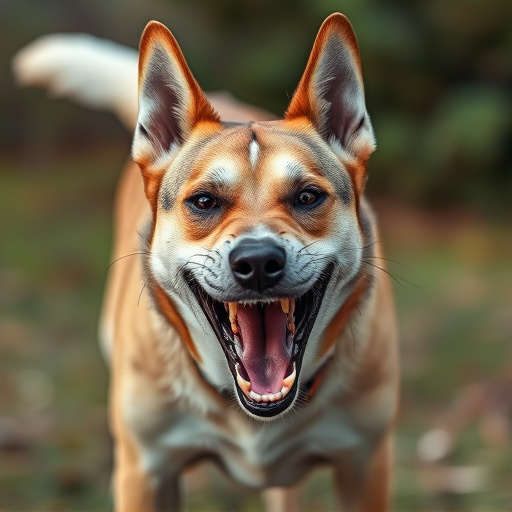Ultrasonic repellent technology creates a "virtual fence" for dogs using inaudible sound waves, effective up to 15-20 feet. Personalization is key, with adjustable settings for frequency and intensity, especially important for large dogs. Training using positive reinforcement ensures pets learn to respond, avoiding activation by smaller animals or objects. Environmental factors like noise, weather, and obstructions can impact range and effectiveness.
“Discover the innovative world of electronic pet deterrents, a game-changer in managing canine behavior. This comprehensive guide explores the science behind ultrasonic repellent technology, offering insights into its remarkable range and efficacy. Learn how adjustable settings cater to specific dog breeds, especially large ones, with tailored protection. We’ll navigate training techniques to ensure pets respond positively to this humane method. By understanding these factors, you can effectively create a peaceful environment for both your home and beloved pets.”
- Understanding Ultrasonic Repellent Technology
- Factors Affecting Range and Efficacy
- Setting Personalized Deterrent Parameters
- Training Pets to Respond and Adapt
Understanding Ultrasonic Repellent Technology
Ultrasonic repellent technology is a non-lethal, humane method to deter animals, particularly dogs, from entering specific areas. This innovative approach utilizes high-frequency sound waves that are inaudible to humans but disruptive to canines. The ultrasonic repellent range for large dogs is typically adjustable, allowing users to set the coverage area according to their needs. By emitting a consistent and controlled frequency, these devices create a “virtual fence” that alerts dogs to their presence, encouraging them to stay away from sensitive areas like gardens, backyards, or even specific rooms in a house.
The technology works on the principle of sensitivity and adaptability. Ultrasonic repelents can detect dog movements and respond accordingly, emitting sound waves only when necessary, which helps conserve battery life. This feature is advantageous for large dogs that might accidentally trigger smaller devices designed for smaller animals. The adjustable settings also accommodate various environments, ensuring effective protection for homes, businesses, or even outdoor spaces in public areas.
Factors Affecting Range and Efficacy
The effectiveness of an electronic pet deterrent, especially an ultrasonic repellent, is influenced by several factors, with one of the key considerations being the Ultrasonic Repellent Range for Large Dogs. The range typically varies depending on the device’s power output and ambient conditions. In ideal scenarios, these deterrents can be effective up to 15-20 feet (or more), but this distance can significantly decrease in environments with high noise levels or significant obstructions like walls or tall grass.
Additionally, the size and behavior of your pet play a role in the deterrent’s success. Larger dogs might require higher frequency settings for optimal results, as they may not be as sensitive to lower-pitched ultrasonic waves. Weather conditions can also impact performance; wind, rain, or humid air can cause the sound waves to disperse more quickly, potentially reducing their intensity and range.
Setting Personalized Deterrent Parameters
When setting up an electronic pet deterrent, one of the key considerations is personalizing the deterrent parameters to suit your specific needs. This involves adjusting various settings, such as frequency and intensity, to ensure optimal effectiveness. For instance, when dealing with large dogs, an ultrasonic repellent range that caters to their heightened sensitivity can be crucial in deterring unwanted behavior without causing discomfort.
By fine-tuning these parameters, pet owners can create a safe environment tailored to their pets’ unique characteristics. The ability to set personalized limits allows for a more precise approach to training and behavioral modification, making the electronic deterrent a versatile tool for various pet ownership scenarios.
Training Pets to Respond and Adapt
Training pets, especially larger dogs, to respond to an ultrasonic repellent range is a crucial step in ensuring its effectiveness. This process involves positive reinforcement techniques where pets are rewarded for staying within the designated area or moving away from trigger zones. Through consistent training sessions, pets learn to associate certain sounds or vibrations with a desired behavior, such as remaining calm or moving to a specific spot.
Adaptability is key when it comes to electronic pet deterrents. These devices can be adjusted to suit different behaviors and sensitivity levels of various dog breeds. The ultrasonic repellent range for large dogs, for instance, can be fine-tuned to avoid unnecessary activation from smaller animals or objects, ensuring the comfort and safety of both pets and their owners while still effectively discouraging unwanted behavior.
An electronic pet deterrent equipped with adjustable settings offers a humane and effective solution for managing behavioral issues. By understanding ultrasonic repellent technology, optimizing range and efficacy through environmental factors, and training pets to respond positively, owners can create an environment that keeps their furry friends safe without causing discomfort. For large dog breeds, carefully adjusting the Ultrasonic Repellent Range ensures targeted deterrence without over-sensitivity, promoting a harmonious coexistence for all.
